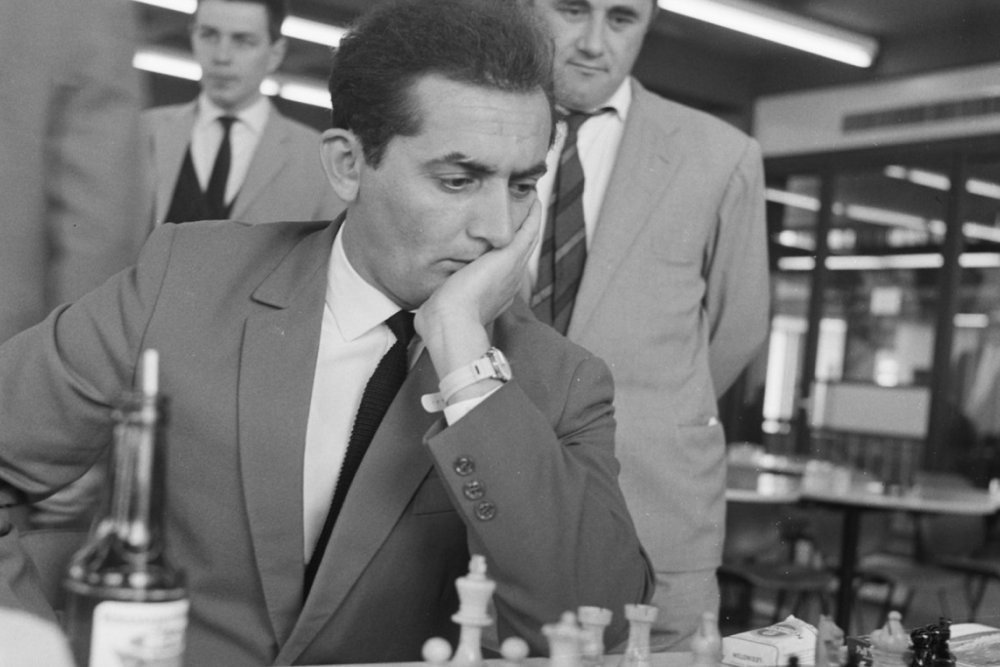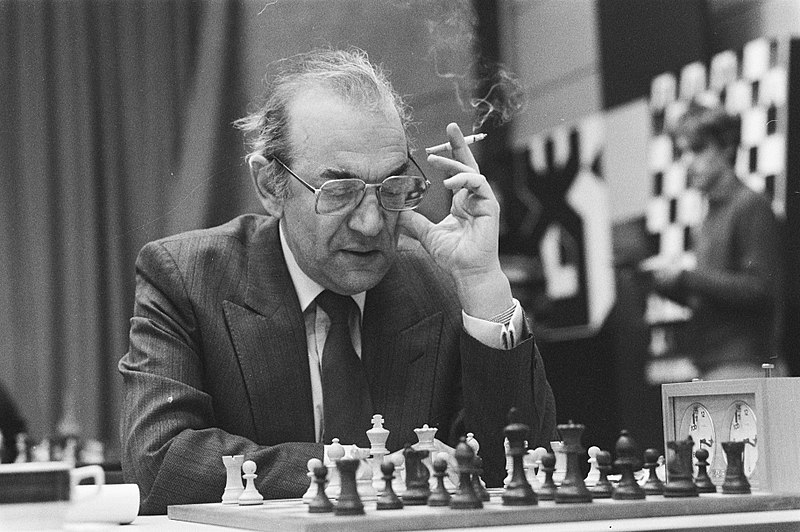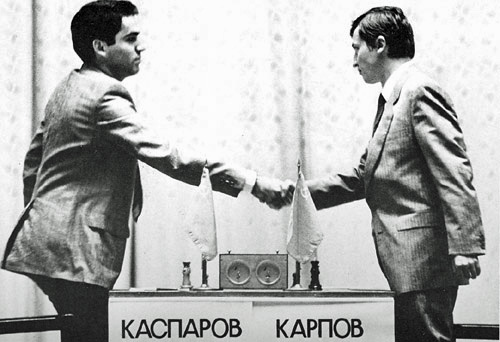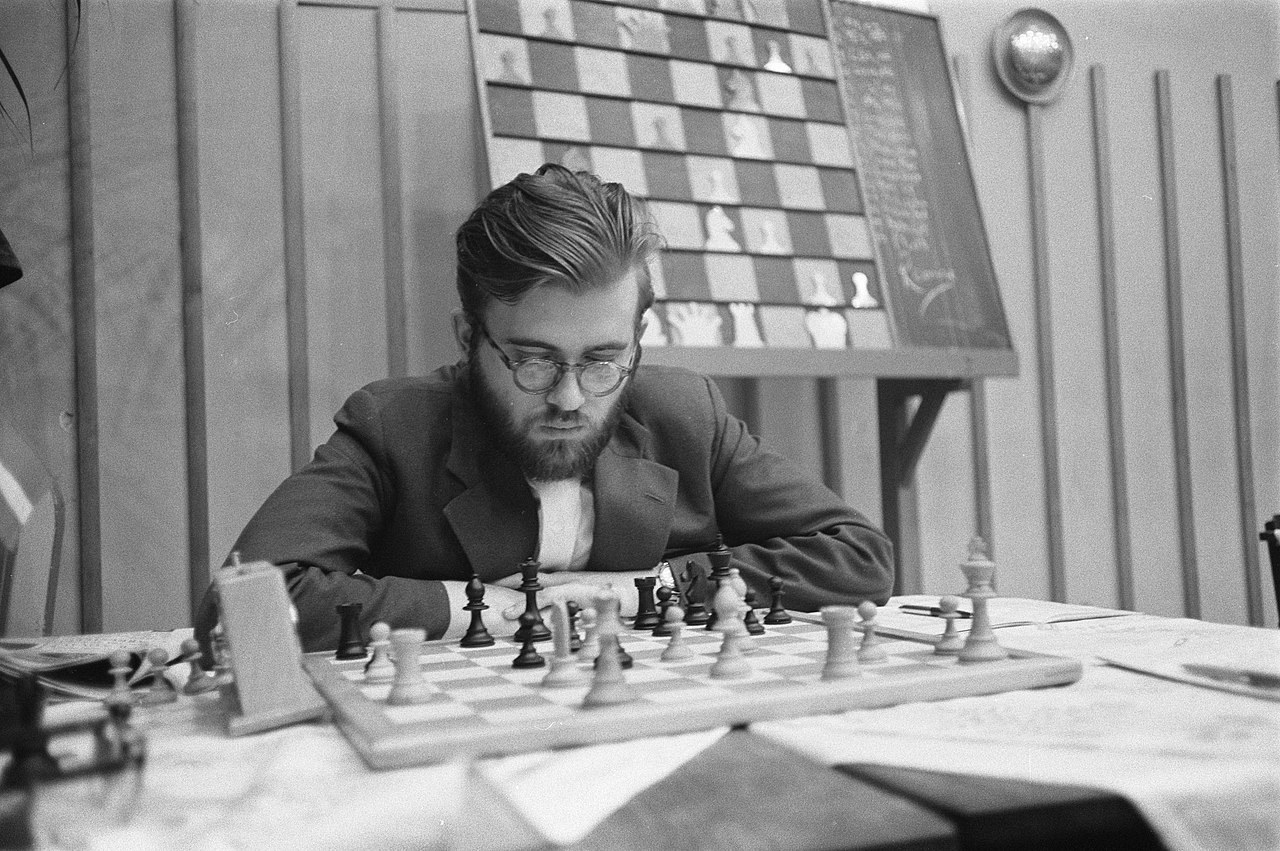


Johannes Fischer: Dear Adrian, you were born in 1954, in Lviv, in Ukraine, which at that time was part of the Soviet Union. How did this affect your chess career and your chess education?
Adrian Mikhalchishin: I was born as one of three sons of refugees from Eastern Poland. They lived in the part of Ukraine which at that time was occupied by Poland. During World War II one of my grandfathers was forced to work for the German Reichsbahn, and in 1944 he died in Berlin from typhus. Later, I tried to find his grave in cemeteries in Marienfelde. GM Uwe Bönsch helped me a lot to find the grave, but in vain. I found only the building, in which he stayed with my father and my grandmother when they were refugees.
My other grandfather was a priest, and he was persecuted by the Polish government. In fact, he was number one on the list of people, who were part of the underground movement, and whom the government to liquidate. He had luck, but his brother in law, who was director of a school, was executed. Later, my grandfather and his three daughters were lucky to escape to the Soviet Union. Even Stalin’s regime, which sent my mother and her younger sister to the Gulag, was less dangerous than the Polish government!
My grandfather was an avid chess player, and when I was seven, my mother taught me to play.
My chess career and my studies (I graduated at the Department of Theoretical Physics in Lvov) benefited from growing up in the Soviet Union because the technical faculties in the Soviet Union were on a very high level. My first Professor was the late Minister of Education, the great Ivan Vakarchuk. He was also a great chess fan and helped to create a strong university team, in which I played. More than once, we finished second in the Ukrainian Team Championships. He is the father of Svyatoslav Vakarchuk, the famous famous pop singer, politician, and public activists. It is interesting to note that quite a few grandmasters studied physics!
I was very lucky to start training in the school of Victor Kart, who was a great trainer and a close friend of Leonid Stein.

Leonid Stein, Amsterdam 1964 | Photo: Dutch National Archive
I studied together with Oleg Romanishin, Aleksander Beliavsky and Marta Litynska but who would have thought that we all would later win Ukrainian and Soviet team Championships! In my career I was lucky to work with excellent trainers, e.g. IM Boris Kogan – he was the trainer of GM Stuart Rachels and died 1993 in Atlanta – or Victor Zheliandinov.
People often talk about the “Soviet School of Chess”. Is there really such a thing and if yes, what are its characteristics?
Well, opinions differ about this question. Boris Spassky, for example, claimed that the Soviet Chess School does not exist! But I think there was such a school, and I think, it was a great school. In fact, players like Tal or Stein said that their generation was taught by Botvinnik!
However, I have to say that the various chess schools in the Soviet Union shared some characteristics, e.g. in regard to studying the classics, but on the other hand there were also local schools with completely different approaches. We knew that players from Georgia and Armenia always tried to exchange their bishops against the knight. The Latvians were attackers with great theoretical knowledge. The players from the Russian Federation were great fighters with an enormous practical strength. The Ukrainians were always more universal players.
There were a number of strong local schools, but it is a curious fact that the two great trainers Victor Kart and Vladimir Zak were born in the same street in the Ukrainian city Berdychiv! And the parents of Boris Postovsky also lived in this street. Postovsky was one of the greatest trainers of the Soviet Union and he captained the Soviet team to four Olympic gold medals!
You were a successful player and you have been a very successful coach. What do you think are your greatest successes as a player and as a trainer?
I won a few international tournaments, e.g. the Banco di Roma tournament in 1978, and I was Soviet U25, Ukrainian and Slovenian Champion, but I believe my best result was the fourth place in the Soviet Championship 1984.
But I was more of a team player, and I won a lot of Ukrainian and Soviet Team Championships, and I later also won team championships in Slovenia, Hungary, Croatia, and Yugoslavia. With my team I won the European Cup 1984, the World Student Championship 1977, and the World Junior Championship 1980.
A crucial moment in my career as a player was a training session Beliavsky, Romanishin and I had with Viktor Kortschnoi in Lviv in 1976. This session left a deep impression! I realized that it is necessary to work to become a strong grandmaster. But a few months after this training session Kortschnoi fled from the USSR, which caused the KGB to ask us a number of questions…

Viktor Kortschnoi 1985 | Photo: Rob Croes, Anefo
As a coach I worked with World Champions such as Maya Chiburdanidze and Anatoly Karpov. When I was coaching Karpov we did a lot of serious work with the great trainer GM Sergei Makarichev (the only person who first trained Karpov and then later Kasparov!), who was coaching the Soviet national team, which won the World Team Championship and the European Team Championship in 1989.
I also often worked as a team captain, and my teams won three times in the Women’s European Cup. I also worked with a number of strong players such as Aleksander Beliavsky, Alisa Maric, Arkady Naiditsch, Ilja Nyzhnyk, Richard Rapport, or three time Polish Champion Mateusz Bartel. I also trained Susan and Sofia Polgar for a few years.
The most memorable moments of my career came during the first two World Championship matches between Karpov and Kasparov. In a long video, which can be found on YouTube, I revealed interesting facts and some background about these matches.

Garry Kasparov and Anatoly Karpov | Photo: Owen Williams, Kasparov Agency
My first non-Soviet student was Lucas Brunner, who became the first Swiss grandmaster. In 1996 he quit his chess career and started to work for the Swiss bank Credit Suisse, whose President Dr.William Wirth was an ardent chess fan and supported the game a lot.
Since 2006 I have also been working with a number of young Turkish players such as Vahap Sanal, Cemil Can Ali Marandi, Batuchan Dastan, Betul Yildiz and Kubra Ozturk, and a lot of them later became grandmasters.
The Dutch project "Young Orange" was also a fantastic experience. It helped to turn Jan Smeets, Daniel Stellwagen, and Erwin l’Ami into grandmasters. Jan and Daniel also studied and even wrote their PhDs, but unfortunately, Daniel somehow vanished from the chess scene, and for five years nobody has heard of him!
With my friend GM Georg Mohr, I also worked in a successful Junior program in Slovenia from which players such as GMs Luka Lenic, Jure Borisek, Jure Skoberne, Matej Sebenik, Jana Krivec, and Ana Srebrnic emerged. Currently, I try to help the Ukrainian star Kiril Shevchenko.
A great success as a coach were also the two silver medals Zhaoqin Peng and Tea Lanchava won at the European Women’s Championship. It took hard work to achieve this.
In the course of your career you played quite number of games. Do you have any favourites?
My wins against Garry Kasparov...
...David Bronstein
...and Alexander Beliavsky
...come to mind.
And do you have a favourite game by another player?
I like Vidmar vs Nimzowich, New York 1927...
...and game 27 of the Karpov vs Kasparov match in Moscow 1984.
Did you have role models as a young player, players that inspired you?
Of course, our Lviv hero Leonid Stein inspired me, and not only me: Beliavsky, Romanishin and Litynska also came to chess because of him. I was also deeply impressed by Bent Larsen.

Bent Larsen | Photo: Harry Pot | Nationaal Archief NL
I even had a notebook with all the games by him that I could find! Bent was an unforgettable character, and when I told him this, he started to laugh!
And did you or do you have a role model as a trainer?
I have met and worked with many great trainers, e.g. Anatoly Bykhovsky, the trainer of the Soviet National Team trainer or Victor Kart, Isaak Boleslavsky, Yury Sakharov or Victor Chebanenko. But it was Mikhail Botvinnik, who had the greatest influence on me, particularly his advice how to study the classics.
Botvinnik had a very peculiar way to give advice. He used to analyse our training games and then told us: "Young guys, if you want to play this kind of position well, study the game Ragozin vs Levenfish from some USSR Championship, and Yudovich vs Goglidze. Then you’ll understand how to handle these positions properly." He had a great knowledge of the relevant classics.
I also had lessons with the founder of modern training, Mark Dvoretsky, and I had training sessions with Yury Razuvaev, the most intellectual trainer. I learned a lot from them. In 1985 my friend Iossif Dorfman and I established a training academy in Lvov. Dorfman is one of the greatest modern trainers. We once played for the same team, but during the first matches between Karpov and Kasparov, we worked in different camps – he worked for Kasparov, I worked for Karpov. Dorfman and I had a few students who became grandmasters, e.g. Alex Sulypa, Andrei Maksimenko and Mikhail Kazakov. Later, they also became renowned trainers.
After us came great trainers like Yaroslaw Srokowsky, who now works in Baden Baden, and Vladimir Grabinsky, who helped to develop a new generation of players from Lvov. No less than twelve of his students became Grandmasters! Recently, my student GM Nazar Firman opened an Academy in Lvov. But we all have the same roots – from the work of the great trainer Alexei Sokolsky, who came to Lviv in 1944 and taught Victor Kart, Leonid Stein and Boris Katalymov, who in turn later became famous trainers in Kazakhstan.
I am indebted to great trainers such as Yury Razuvaev, Mark Dvoretsky, Anatoli Bykhovsky, Yuri Sakharov, Victor Kart, and Boris Postovsky, and I also studied with a few modern great trainers: Arshak Petrosian, Iossif Dorfman, Elizbar Ubilava and Vladimir Tukmakov.
I also study the work of great trainers in other sports, and I like the advice of legendary Basketball coach Pat Riley: "Hard work will never guarantee you the success, but without it any success is impossible!"
Part II will follow soon...